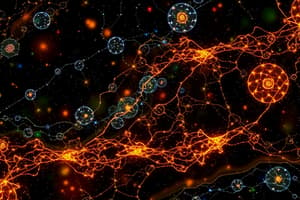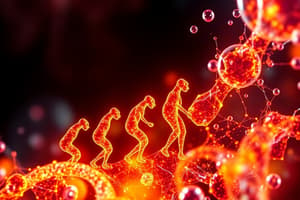Podcast
Questions and Answers
What is the main purpose of homeostasis in living organisms?
What is the main purpose of homeostasis in living organisms?
- To facilitate rapid reproduction
- To ensure genetic diversity
- To optimize growth rates
- To maintain stable internal conditions (correct)
Which of the following statements about ATP is true?
Which of the following statements about ATP is true?
- ATP is not crucial for cellular processes.
- ATP is produced by direct sunlight only.
- Only plant cells require ATP for energy.
- All living organisms depend on ATP for survival. (correct)
Which reproduction process results in genetically identical offspring?
Which reproduction process results in genetically identical offspring?
- Sexual reproduction
- Asexual reproduction (correct)
- Metamorphosis
- Fertilization
What is the main purpose of using Bacillus Thuringiensis (BT) in agriculture?
What is the main purpose of using Bacillus Thuringiensis (BT) in agriculture?
Which of the following best describes genetic engineering?
Which of the following best describes genetic engineering?
What condition is caused by the body's inability to process phenylalanine?
What condition is caused by the body's inability to process phenylalanine?
Which genetically modified crop was developed to resist browning after being cut?
Which genetically modified crop was developed to resist browning after being cut?
Which of the following is a potential benefit of genetically modified organisms (GMOs)?
Which of the following is a potential benefit of genetically modified organisms (GMOs)?
What is the outcome of the fragmentation process in starfish?
What is the outcome of the fragmentation process in starfish?
Which of the following conditions can be a concern regarding GMOs?
Which of the following conditions can be a concern regarding GMOs?
What is the primary role of the circulatory system?
What is the primary role of the circulatory system?
Which statement accurately describes a homologous structure?
Which statement accurately describes a homologous structure?
What defines a vestigial structure?
What defines a vestigial structure?
How do fossils contribute to our understanding of evolution?
How do fossils contribute to our understanding of evolution?
What does the term 'speciation' refer to?
What does the term 'speciation' refer to?
Which system is primarily responsible for gas exchange in the body?
Which system is primarily responsible for gas exchange in the body?
What best describes analogous structures?
What best describes analogous structures?
Which system is primarily responsible for regulating growth and metabolism through hormones?
Which system is primarily responsible for regulating growth and metabolism through hormones?
What evidence does molecular biology provide regarding evolutionary relationships?
What evidence does molecular biology provide regarding evolutionary relationships?
What is the meaning of biodiversity?
What is the meaning of biodiversity?
Which natural cause of extinction involves the alteration of atmospheric composition due to pollutants?
Which natural cause of extinction involves the alteration of atmospheric composition due to pollutants?
What term describes the capacity of an ecosystem to sustain a population without causing harm?
What term describes the capacity of an ecosystem to sustain a population without causing harm?
Which factor is considered an example of environmental resistance?
Which factor is considered an example of environmental resistance?
What component is NOT a human cause of extinction?
What component is NOT a human cause of extinction?
Biotic potential is most closely associated with which of the following characteristics?
Biotic potential is most closely associated with which of the following characteristics?
Which of the following represents a consequence of acid rain?
Which of the following represents a consequence of acid rain?
What factor significantly limits a population's ability to reach its biotic potential?
What factor significantly limits a population's ability to reach its biotic potential?
Which of the following is NOT a consequence of habitat destruction?
Which of the following is NOT a consequence of habitat destruction?
How does overharvesting negatively impact species survival?
How does overharvesting negatively impact species survival?
In what way does climatic heating primarily contribute to extinction?
In what way does climatic heating primarily contribute to extinction?
Which theory suggests that life originated through chemical reactions over time?
Which theory suggests that life originated through chemical reactions over time?
What is the primary distinction between prokaryotes and eukaryotes?
What is the primary distinction between prokaryotes and eukaryotes?
Which theory states that new living organisms arise only from existing living organisms?
Which theory states that new living organisms arise only from existing living organisms?
How do organisms adapt over generations?
How do organisms adapt over generations?
Which process is essential for maintaining stable internal conditions in living organisms?
Which process is essential for maintaining stable internal conditions in living organisms?
What role does sunlight play in the ecosystem?
What role does sunlight play in the ecosystem?
Which of the following best describes cyanobacteria?
Which of the following best describes cyanobacteria?
In which theory is it suggested that life may have originated from ice in space?
In which theory is it suggested that life may have originated from ice in space?
Which example illustrates the concept of response to stimuli?
Which example illustrates the concept of response to stimuli?
What does the term 'abiotic' refer to?
What does the term 'abiotic' refer to?
Flashcards
Theory of Biochemical Evolution
Theory of Biochemical Evolution
Life on Earth originated from gradual chemical reactions.
Deep Sea Hydrothermal Vent Theory
Deep Sea Hydrothermal Vent Theory
Life started near underwater volcanic vents.
Biogenesis Theory
Biogenesis Theory
Life comes from other life.
Prokaryotes
Prokaryotes
Signup and view all the flashcards
Eukaryotes
Eukaryotes
Signup and view all the flashcards
Growth and Development
Growth and Development
Signup and view all the flashcards
Homeostasis
Homeostasis
Signup and view all the flashcards
Response to Stimuli
Response to Stimuli
Signup and view all the flashcards
Biotic
Biotic
Signup and view all the flashcards
Abiotic
Abiotic
Signup and view all the flashcards
Circulatory System
Circulatory System
Signup and view all the flashcards
Respiratory System
Respiratory System
Signup and view all the flashcards
Excretory System
Excretory System
Signup and view all the flashcards
Nervous System
Nervous System
Signup and view all the flashcards
ATP
ATP
Signup and view all the flashcards
Immune System
Immune System
Signup and view all the flashcards
Sexual Reproduction
Sexual Reproduction
Signup and view all the flashcards
Digestive System
Digestive System
Signup and view all the flashcards
Endocrine System
Endocrine System
Signup and view all the flashcards
Asexual Reproduction
Asexual Reproduction
Signup and view all the flashcards
Genetic Engineering
Genetic Engineering
Signup and view all the flashcards
Extinction
Extinction
Signup and view all the flashcards
BT (Bacillus Thuringiensis)
BT (Bacillus Thuringiensis)
Signup and view all the flashcards
Homologous Structures
Homologous Structures
Signup and view all the flashcards
Analogous Structures
Analogous Structures
Signup and view all the flashcards
Phenylketonuria (PKU)
Phenylketonuria (PKU)
Signup and view all the flashcards
GMO
GMO
Signup and view all the flashcards
Bt Eggplant
Bt Eggplant
Signup and view all the flashcards
GM Apple
GM Apple
Signup and view all the flashcards
Biotic Potential
Biotic Potential
Signup and view all the flashcards
Carrying Capacity
Carrying Capacity
Signup and view all the flashcards
High Birth Rate
High Birth Rate
Signup and view all the flashcards
Environmental Resistance
Environmental Resistance
Signup and view all the flashcards
Predation
Predation
Signup and view all the flashcards
Acid Rain
Acid Rain
Signup and view all the flashcards
Climatic Change
Climatic Change
Signup and view all the flashcards
Habitat Destruction
Habitat Destruction
Signup and view all the flashcards
Overharvesting
Overharvesting
Signup and view all the flashcards
Pollution
Pollution
Signup and view all the flashcards
Study Notes
Evolving Concept of Life
- Theory of Biochemical Evolution: Proposes life arose from chemical reactions, perhaps in hydrothermal vents.
- Deep Sea Hydrothermal Vent Theory: Suggests life began near underwater volcanic vents, in mineral-rich water.
- Biogenesis Theory: States that life comes from pre-existing life.
- Creation Theory: A supreme being created all life.
- Spontaneous Generation Theory: Incorrectly believed living organisms could arise from non-living matter.
- Panspermia Theory: Life originated in space and spread to other planets.
Essential Terminologies
- Prokaryotes: Lack a true nucleus.
- Eukaryotes: Have a nucleus and other membrane-bound organelles.
- Cyanobacteria: Early photosynthetic organisms.
- Trilobites: Early arthropods.
- Cephalopods: An advanced group of mollusks (e.g., octopuses, squid).
Unifying Themes of Life
- Growth and Development: Physical and biological changes, including function and behavior.
- Response to Stimuli: Example: Mimosa pudica wilting when touched.
- Homeostasis: Maintaining internal stability (e.g., temperature, moisture).
- Structure and Function: Organisms adapt to their environments through structural changes.
- Biotic and Abiotic Factors: Interactions of living (biotic) and non-living (abiotic) components of ecosystems.
- Energy and Life: Energy is needed for activities like movement and reproduction; it comes from chemical reactions. Energy enters ecosystems as sunlight and exists as heat.
Perpetuation of Life
- Sexual Reproduction: Combining genetic material from two parents.
- Asexual Reproduction: Offspring genetically identical to the parent.
- Hydras: Reproduce via budding.
- Fragmentation: Body part regeneration into a new individual (e.g., starfish).
- Parthenogenesis: Development from an unfertilized egg (e.g., some insects).
- Binary Fission: Cell division resulting in two identical cells.
Genetic Engineering and GMOs
- Genetic Engineering: Modifying an organism's DNA.
- GMO: Genetically modified organism.
- Bacillus thuringiensis (Bt): Used to control pests.
- Phenylketonuria (PKU): Genetic disorder affecting amino acid processing.
- Beta-carotene: Added to golden rice through genetic modification.
Organ Systems In Representative Animals
- Circulatory: Transports oxygen and other essentials.
- Respiratory: Exchanges gases.
- Excretory: Removes metabolic wastes.
- Nervous: Deals with awareness, emotions.
- Immune: Protects against disease.
- Digestive: Converts food into nutrients.
- Endocrine: Regulates hormones, influencing growth and mood.
Mass Extinction
- Extinction: A species disappearing from Earth.
- Evidence of Evolution: Anatomical similarities, embryonic development, biochemical comparisons, and fossils.
- Comparative Anatomy: Homologous structures share similarities in structure, analogous structures share functions, vestigial structures have lost function.
Other Topics
- Speciation: Formation of new species.
- Biodiversity: Variation in the types and numbers of living organisms.
- Natural Causes of Extinction: Acid rain, climate change, asteroid impacts, disease.
- Human Causes of Extinction: Habitat destruction, overhunting, pollution.
- Biotic Potential: Ability of a species to increase its population in ideal conditions.
- Environmental Resistance: Factors limiting population increase, like predation.
- Carrying Capacity: Maximum population size an environment can support.
Studying That Suits You
Use AI to generate personalized quizzes and flashcards to suit your learning preferences.



